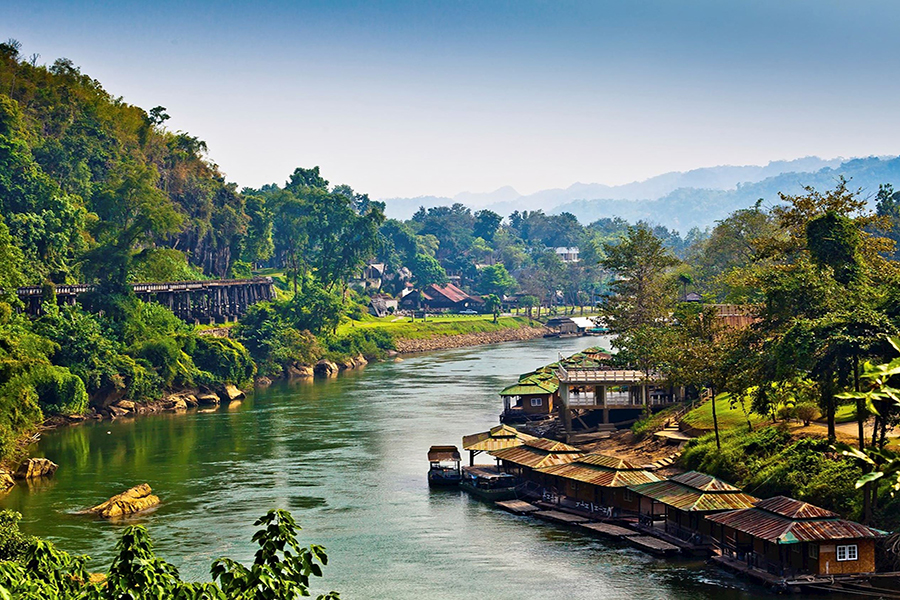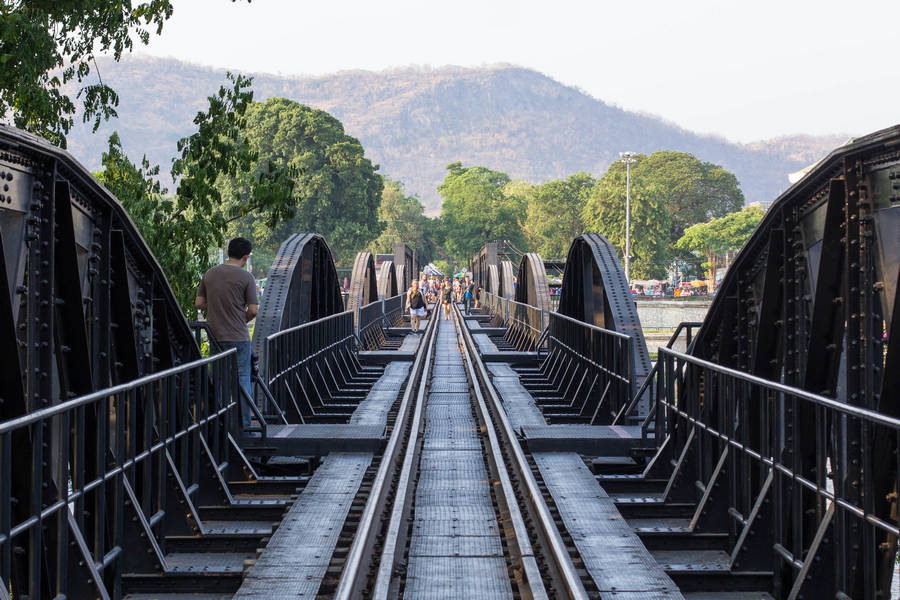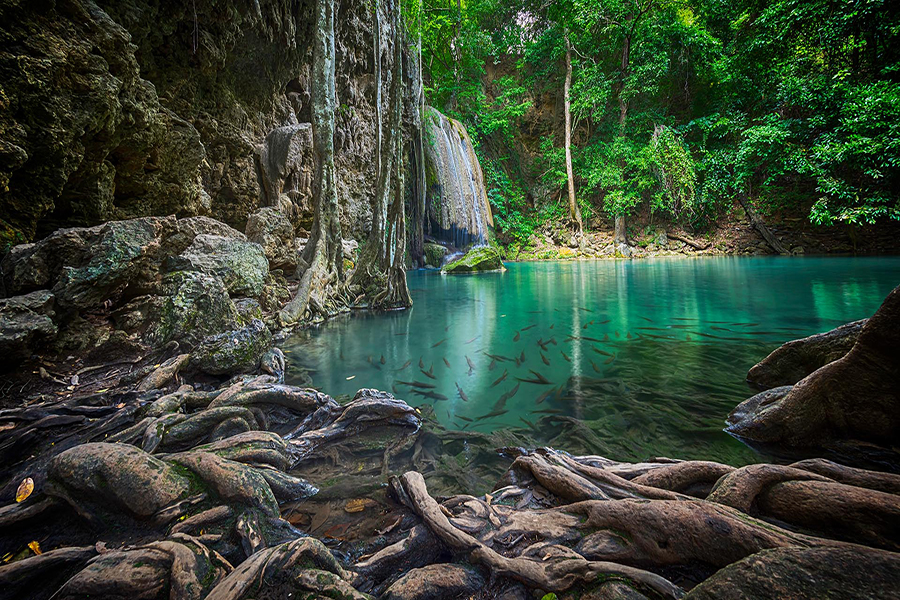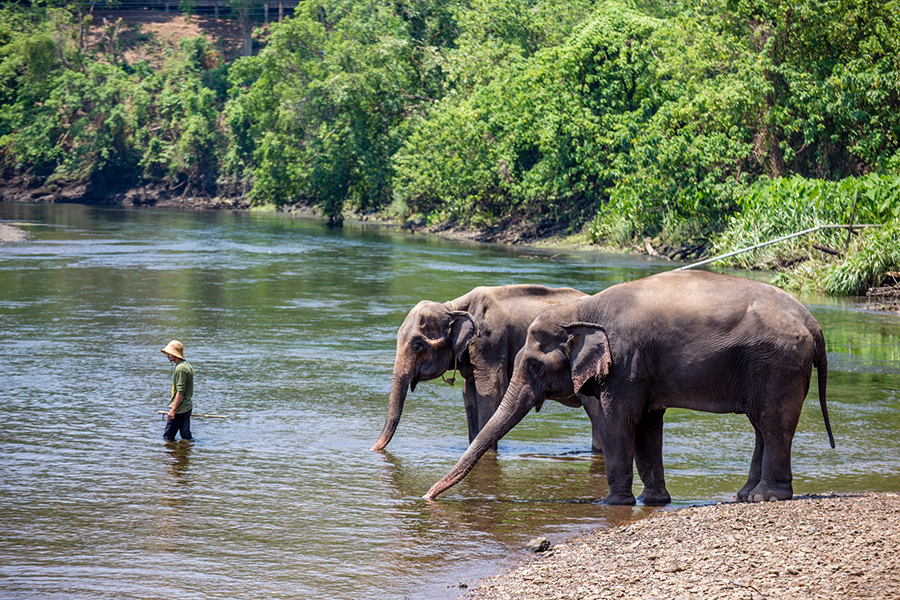Kanchanaburi

Most of Kanchanaburi consists of mountainous terrain with an area of approximately 19,473 km². This makes Kanchanaburi the third largest province in Thailand after Nakhon Ratchasima and Chiang Mai. The province is approximately 130 km west of Bangkok, bordered by Tak and Uthai Thani provinces to the north, Suphan Buri and Nakhon Pathom provinces to the east, and Ratchaburi province to the south.

The river Kwai of Kanchanaburi (Source: Audley Travel)
Kanchanaburi's majestic scenery and captivating beauty have created many tourist attractions. Most visitors to the province are drawn to its famous waterfalls, prehistoric caves, pristine national parks, virgin forests, and reservoirs. All of these offer an exciting experience for first-time and repeat visitors.
Activities such as fishing, boating, mountain biking, bird watching, stargazing, golfing, hot springs, elephant riding, and jungle trekking are all fully provided by Kanchanaburi for tourists. With the diversity of activities, Kanchanaburi is a place you should visit during your trip to Thailand.
Archaeological remains found in Kanchanaburi suggest that the area was inhabited as early as the 4th century. There is little recorded information about the Khmer influence in Kanchanaburi. Fortunately, one of the country's most famous Khmer sites, Prasat Muang Sing, provides evidence of their presence.
Before the reign of King Rama I, there were few records of Kanchanaburi province, but some historians believe that it was strategically important during the Ayutthaya period. Several human and elephant skeletons were found in Phanom Thuan in 1982. This has led to speculation that the area may have been the site of a battle between King Naresuan and a Burmese prince.
Most foreigners know of Kanchanaburi's recent history concerning the Burma Railway. In 1942, when Japan occupied Thailand, allied prisoners of war and Asian laborers were required by Japan to build the Thailand-Burma railway. Ultimately, the harsh working conditions caused the deaths of 16,000 prisoners of war and 90,000 laborers.
The best time to visit most of Kanchanaburi is from November to March. During this period, visitors will enjoy cooler weather and less rain. Visiting major tourist attractions such as the River Kwai Bridge and Tham Krasae Bridge is safer on sunny days with dry ground.

Bridge over the River Kwai (Source: The lost passport)
From April to June, temperature and humidity can be challenging for the trip to Kanchanaburi and cause discomfort. April often sees temperatures exceeding 40°C and humidity approaching 100%, so this is considered the worst month to visit Kanchanaburi.
The rainy season lasts from July to the end of October, but rainfall decreases towards the end of the season. During the rainy season, it is rare to have a full day of rain, usually lasting no more than a few hours, and then hot weather. This period can be a good time to visit Erawan Waterfall, as the pools are filled with water and the cascading falls are quite spectacular.
See more: Thailand Tour Package 7 days: Bangkok & Chiang Mai
The most famous tourist attraction in Kanchanaburi is the Death Railway Bridge or Bridge on the River Kwai. It was featured in the Oscar-winning film “The Bridge on the River Kwai”. It is also known as part of the Thai-Burma railway. To build this bridge, hundreds of thousands of British, Dutch, Australian, and American soldier prisoners along with Southeast Asian laborers died due to harsh working conditions.

Death Railway Bridge (Source: Fan Club Thailand)
The reason is that after invading Thailand, during World War II, Japan also wanted to invade Burma. So they planned to deliver weapons and soldiers to Burma through this bridge. Today, to commemorate this tragic loss, the war prisoners have been buried in the Kanchanaburi Cemetery.
From the River Kwai Bridge, visitors can walk to the JEATH War Museum, located on the grounds of a temple called Wat Chai Chumphon. This museum displays war relics, letters, and artwork from prisoners of war, and their family members, including interviews with prisoners of war.

Images of POWs being forced to work to build the Thailand-Burma railway (Source: Kanchanaburi Car Rental)
An interesting thing that visitors can find here is a gallery designed as a bamboo shelter called Attap. This place is where prisoners lived during the war. Next to this museum is a majestic Buddhist temple, where visitors can visit to admire the beautiful murals.
Chungkai War Cemetery is located about 3 km south of the Bridge on the River Kwai on the banks of the Kwai Noi River. It was the main site of an Allied prisoner-of-war camp during World War II. During this time, the prisoners even built their hospital and chapel nearby.

Chungkai War Cemetery (Source: Common Wealth War Graves)
This well-maintained cemetery houses the graves of 1,400 Commonwealth soldiers and 300 Dutch soldiers. Although it is a peaceful place filled with trees and flowers, it still evokes a disheartening atmosphere because of its tragic history.
This wonderful museum chronicles the history with stories of the POWs and other internment workers who endured while building the Thai-Burma Railway.
Mostly it tells the journey of the railway workers from being transported in cramped train cars to disease-ridden jungle labour camps, as well as the fate of those who survived the war.
Erawan National Park in Kanchanaburi Province, with its mountainous terrain and pristine forests, is one of the most important nature reserves in the region and Thailand.

Erawan National Park (Source: KohPlanner)
This national park is famous for its unique waterfalls, with a total of 7 levels of water flowing down from the top of the mountain. These waterfalls are numbered from 1 to 7 and are named after the seven-headed dragon in Thai legend. Each level of the waterfall has its own unique characteristics and beauty.
In addition, Erawan National Park also has pristine forests and rich biodiversity, including more than 500 species of flora and fauna. Many wild animals live in this area including bears, monkeys, deer, elephants, and leopards. This creates a wild and advanced tourism experience in the middle of nature.
Elephants World provides a safe haven for rescued and injured elephants with the philosophy of “We should work for the elephants, not make the elephants work for us”.

Elephants World in Kanchanaburi (Souce: Amazing Asia Tours)
Located on the banks of the Khwae Yai River, Elephants World is a shelter of love for over 30 elephants. There is no riding and no hooks are used. For anyone looking for an ethical experience with elephants in Thailand, Elephants World is a great choice.
Bus: The ideal way to get to Kanchanaburi is by bus from Bangkok's Southern Bus Terminal. Buses run from 4 am to 8 pm and take around 3 hours. Alternatively, you can opt for the first-class air-conditioned bus service. These buses also depart from the same terminal but depart less frequently.
Minivan: The quickest and easiest way to get to Kanchanaburi from Bangkok is by minivan. Fares start from just 150 THB per person. Minivans depart from Mochi Bus Terminal and the journey takes around 3 hours.
Train: Trains in Bangkok are slow and uncomfortable. But if you still want to take the train to Kanchanaburi, you can board at Thonburi Station for around 100 THB per person. The journey can take anywhere from 3 to 6 hours.
Taxi: A taxi ride from Bangkok to Kanchanaburi costs between 1,600 and 2,000 THB one way. The travel time is not much different from that of a minivan. You can hail a taxi in Bangkok and negotiate the price.
Rental car: Renting a car is a faster and more convenient form of transportation than the above. You can rest assured because the price and quality of the car are fixed and disclosed to you before departure.
Prepare for an exciting day with our Kanchanaburi Tour Full Day, where you'll ex...
Experience the rich history and natural beauty of Kanchanaburi with our "Kanchan...
"Kanchanaburi Tour 3 Days: Step Back in Time" offers a comprehensive journey th...
Explore history and nature on this Kanchanaburi Tour 2 Days. Immerse yourself in...
Embark on a fascinating 3-day journey through Kanchanaburi, where history, natur...